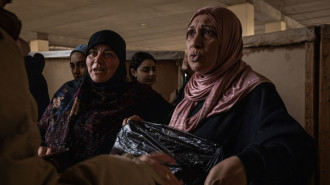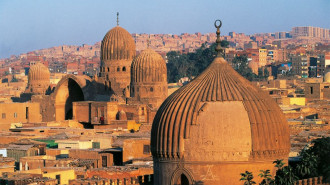
A tale of two cities and climate change: What can we learn from the Dubai and Muscat floods?

Heavy clouds burst over the concrete metropolises of the UAE and Omani mountainsides in mid-April, submerging homes, cars, and vegetation in both Gulf states.
On April 16, the UAE experienced its heaviest rainfall recorded when 100mm of rain poured down on Dubai over 12 hours — a level usually witnessed over a whole year — while Oman saw similar downpours with 21 people killed in flash floods.
"Urban planners and scientists warn that Oman and the UAE will need to adapt their cities for more extreme weather due to global warming"
Satellite imagery showed unprecedented pools of water dabbing the khaki landscapes of the eastern Arabian Peninsula.
Oman and parts of the UAE are no strangers to storms and cyclones but urban planners and scientists warn that both countries will need to adapt their cities for more extreme weather due to global warming.
City planners took two very different approaches during the development of Muscat and Dubai after the oil boom of the 1970s, with recent events highlighting some of the pitfalls and benefits of each model.
Muscat, low-rise and sprawling, saw villas, malls, and roads underwater for days during cyclones Gonu in 2007 and Phet in 2010, but — as recent weeks showed — authorities have adapted well to the new environment and the Omani capital was largely spared the worst of the flooding last week.
However, Dubai, a futuristic cityscape familiar to millions, fared less well with its concrete mantle collecting thousands of litres of rainwater and with nowhere to escape, overwhelmed the city's landmarks with colossal water surges.
|
Dubai
Remarkable scenes were screened of Emirates aircraft wading through inches of water on the tarmac of Dubai International Airport, whilst crowds of tourists inside the terminal camped out for long delays.
Whether this was a once-in-a-lifetime calamity or a sign of things to come, experts say an urgent better drainage and more green spaces, to allow for pools of water to subside during the next cloud burst.
"The UAE government will likely have to adapt urban planning — this could involve improved drainage systems, green spaces for water absorption, and heat resistant materials"
One UAE-based urban planner, who wanted to remain anonymous for this article, said a combination of infrastructure and environmental issues led to the flooding in Dubai but this offers an opportunity for more liveable and infrastructurally-sound cities.
"The UAE government will likely have to adapt urban planning — this could involve improved drainage systems, green spaces for water absorption, and heat resistant materials," the source told The New Arab.
"Dubai's reliance on a desert climate model in urban planning might need adjustments. Dubai’s cityscape might need more green spaces and sustainable architecture to cope with extreme weather.
"There are signs of change and the government is discussing these issues more openly, but implementing large-scale changes takes time."
UAE President Sheikh Mohammed bin Zayed Al-Nahyan appears to acknowledge this, ordering a review of national infrastructure in this geographically diverse country shortly after the floods.
Dubai ruler and UAE Prime Minister Sheikh Mohammed bin Rashid Al-Maktoum said the emirate had learned lessons from the tragedy with two ministerial committees formed, one to handle a $544 million flood compensation fund and another to assess the damage and provide solutions for the future.
"The storm has identified a weak point that the UAE will have to fix and useful information that we can use to improve security and livability"
Dr Jim Krane, Wallace S. Wilson Fellow for Energy Studies at Rice University and the author of two books on Dubai noted how Gulf states often skipped the construction of drainage during the expansion of their cities in the 1980s and 1990s when the effects of climate change were less evident.
Now, Mother Nature is catching up on these shortcuts with devastating consequences for the Gulf region.
"Climate adaptation is already underway in all developed economies and Dubai is no exception, so there will be a reckoning after the recent storm and we'll see an infrastructure response," Krane told The New Arab.
"Drainage is a major issue, of course, and at some point Dubai and the rest of the Gulf will have to grapple with rising sea levels. Gulf cities need flood maps and drainage master plans, just like other low-lying and flood-prone areas."
Lessons can be learned from Houston, Texas he said, which after years of flooding from waves of tropical storms invested heavily in drainage and raising bridges.
Dubai might also benefit from techniques learned when building artificial islands, where sand dredged from the sea bottom was piled high on the emirate's shores.
"Building coastal defences is already a Dubai speciality, and it will help the city adapt more broadly. I'm pretty confident it can cope with near-term climate damages, but as global warming intensifies, Dubai and the Gulf will find themselves in a tough position," he added.
"The storm has identified a weak point that the UAE will have to fix and useful information that we can use to improve security and livability. It's up to the authorities to lead the way, adaptation is going to be the name of the game after this storm."
|
Muscat
Oman, as part of the Indian Ocean region, is more prone to cyclones and other extreme weather than its northern neighbour, but the precipitation also helps water the sultanate's rich agricultural lands and the juniper forests of the interior.
Muscat largely escaped the devastation unleashed on other parts of Oman last week, in part due to the lessons learned from cyclones Gonu and Phet, said Dr Ahmed Hadidi, Assistant Professor for Hydrogeology at GUtech in Muscat.
This involved the creation of the National Center for Early Warning of Multi-hazards, which undoubtedly reduced the impact of Cyclone Mekunu in 2018 and Shaheen in 2020.
"This centre helped to raise the awareness of different governmental authorities as well as the public to be proactive and ready for these events," he told The New Arab.
"Schools are often closed during the rainfall and while many people complain about this, doing this during the last event reduced traffic a lot and hence made the people safer."
The government also established a mobile-based Early Warning System, flagging residents and nationals about flash floods and potential tsunamis in coastal areas via phone alerts, as well as a state-of-the-art flood guidance system which will be active next year.
"This system is expected to issue warnings with details about the affected areas. As of now, announcements and reports are general such as requests to avoid crossing running wadis," he said.
Driving through wadis, which often transform into fast-flowing torrents during storms, can be fatal with ten Omani children tragically killed on April 14 when a school bus failed to navigate an overflowing wadi.
"More than 150 dams have been built across the sultanate, three of them to protect downstream areas in Salalah, Dayqah and Sur, and the rest for water storage and groundwater discharge"
Due to the sultanate's rocky make-up, heavy rain often cascades down mountainsides toward wadis and low-lying areas below, often the location of towns, villages, and vital infrastructure, such as roads.
The government has sought to reduce the dangers to its population by issuing heavy fines for drivers crossing wadis during wet weather, and constructing signage indicating where submerged roads are too deep to cross, as well as culvert boxes.
More than 150 dams have been built across the sultanate, three of them to protect downstream areas in Salalah, Dayqah and Sur, and the rest for water storage and groundwater discharge, added Hadidi.
"Considering the very low population density and sparse distribution of urbanised areas — basically concentrated in northern Oman — it is very expensive and not feasible to protect all urbanised areas in Oman with dams," he said.
"Flash floods used to happen a long time ago, but the urban development and the increase in population put us closer to these events. Flash floods among other natural disasters might be tackled in two ways: mitigation and adaptation. According to that, adaptation is part of the solution."
|
No turning back?
Scientists from the World Weather Attribution group said on April 25 that climate change, caused in part by fossil fuel emissions, was a probable cause of the recent flooding and noted that rainfall in this Gulf region was 10 to 40 percent heavier during El Niño years.
For some, the fast-rising global temperature means the world is at a point of almost no return and no amount of drainage will be enough to stop the flooding of coastal regions.
"If we re-run our risk assessments now there is a high probability that this sort of thing will happen again. Unless we take very radical action to tackle the environment, there is just no way we can prepare our cities for what is in the pipeline"
Dr Philipp Rode, Executive Director of LSE Cities and Associate Professor at the School of Public Policy said collective action to tackle the climate catastrophe is the only solution for Gulf states.
The UAE, which hosted the COP28 summit last year, can play a major role in using its resources and expertise to work toward sustainable urban development and the transition toward next-generation energy generation.
"The overarching story is that with dramatic and very unpredictable changes in the global environment taking place, we will see more and more situations where technical systems, set up when climate change was not in mind, are now being overwhelmed," said Rode.
"You might have had a 0.1 percent chance of something like this happening 20 or 30 years ago, but if we re-run our risk assessments now there is a high probability that this sort of thing will happen again. Unless we take very radical action to tackle the environment, there is just no way we can prepare our cities for what is in the pipeline."
Dubai can learn from Bangkok, Tokyo and cities in the Netherlands where major infrastructure and urban adaptions have helped them cope with flooding but perhaps the most relatable example is Copenhagen which witnessed a devastating cloud burst in 2011.
The Danish capital was a similar amalgamation of concrete and asphalt as Dubai but today tops 'most liveable cities' lists due to the adaptations made after the flooding, including more green spaces to absorb rainwater.
"All these examples are still very different to the situation in Dubai and I suspect that in some ways there is an opportunity that it will have to invent something that is hyper-contextualised and very specific to this type of rapid, desert city which lies on the sea and doesn't get a lot of water," Rode said.
|
Dubai can learn from Muscat also, where mangroves were planted in the city that help with water absorption. The UAE can also tap into dynamic local and international urban planners and architects to help transform Dubai and other cities, largely planned by outside contractors, for a new age.
This will include re-assessing Dubai’s brand as a global tourism and transport hub, as well as melding the realities of rising sea levels and more extreme weather with this hyper-connected world we live in.
Traditional and less energy-intensive local and regional cooling techniques, such as narrow alleyways and shaded courtyards, could contribute to this but ultimately it will require out-of-the-box thinking and revolutionary solutions from the Gulf states.
"We're now talking about a situation where you do wonder, what is the local contextual expertise to actually deal with (flooding) at this scale, and I suspect... it will require searching around the world for solutions," he said.
"If it is about resilience then it's about something deeper than branding exercises… so it's a very uncomfortable message for Dubai, Abu Dhabi and the rest of the region but the sooner that message [about climate change] is taken seriously the better for future generations."
Paul McLoughlin is a senior news editor at The New Arab
Follow him on Twitter: @PaullMcLoughlin
![Palestinians mourned the victims of an Israeli strike on Deir al-Balah [Getty]](/sites/default/files/styles/image_684x385/public/2024-11/GettyImages-2182362043.jpg?h=199d8c1f&itok=xSHZFbmc)


![The law could be enforced against teachers without prior notice [Getty]](/sites/default/files/styles/image_684x385/public/2178740715.jpeg?h=a5f2f23a&itok=hnqrCS4x)
 Follow the Middle East's top stories in English at The New Arab on Google News
Follow the Middle East's top stories in English at The New Arab on Google News


